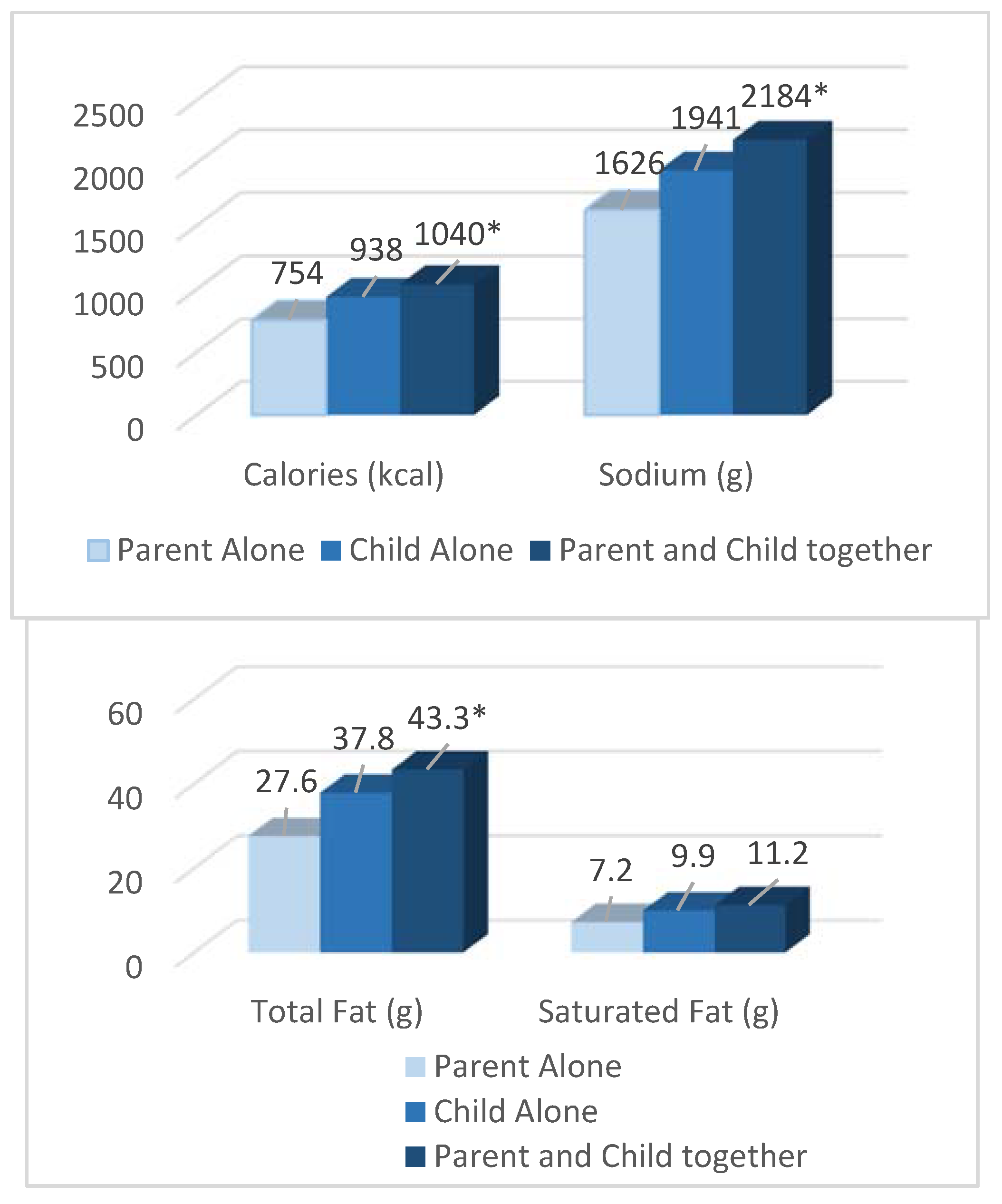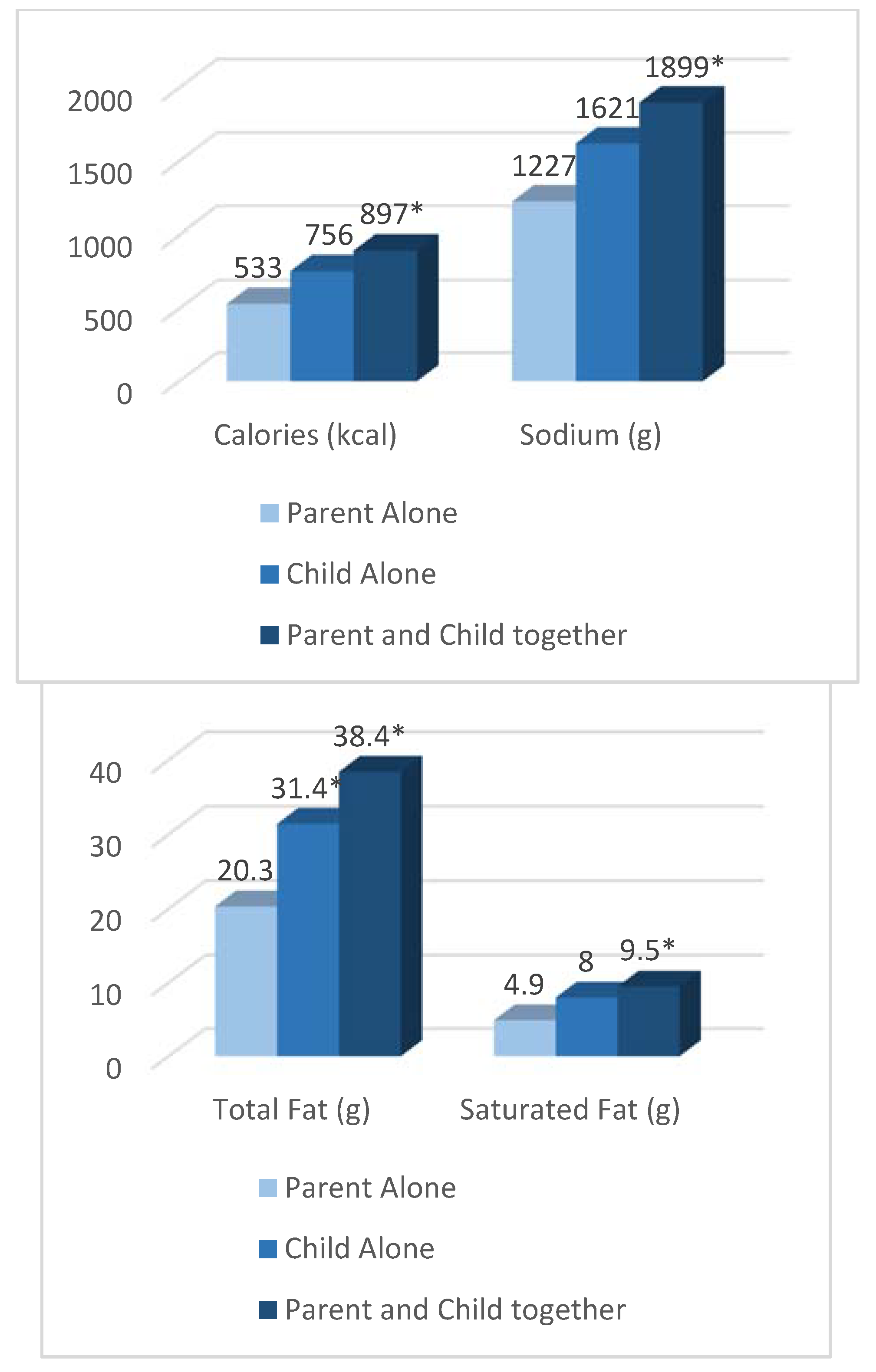The Role of Parents and Children in Meal Selection and Consumption in Quick Service Restaurants
Abstract
1. Introduction
2. Materials and Methods
2.1. Participants and Recruitment
2.2. Plate-Waste Methodology
2.3. Analyses
3. Results
4. Discussion
5. Conclusions
Author Contributions
Funding
Conflicts of Interest
References
- Schlosser, E. Fast Food Nation: The Dark Side of the All-American Meal; Houghton Mifflin Harcourt: Boston, MA, USA, 2012. [Google Scholar]
- Guthrie, J.F.; Lin, B.-H.; Frazao, E. Role of food prepared away from home in the American diet, 1977–1978 versus 1994–1996: Changes and consequences. J. Nutr. Educ. Behav. 2002, 34, 140–150. [Google Scholar] [CrossRef]
- Vikraman, S.; Fryar, C.D.; Ogden, C.L. Caloric Intake from Fast Food among Children and Adolescents in the United States, 2011–2012; Centers for Disease Control and Prevention; National Center for Health Statistics: Hyattsville, MD, USA, 2015. [Google Scholar]
- Poti, J.M.; Slining, M.M.; Popkin, B.M. Where are kids getting their empty calories? Stores, schools, and fast-food restaurants each played an important role in empty calorie intake among US children during 2009–2010. J. Acad. Nutr. Diet. 2014, 114, 908–917. [Google Scholar] [CrossRef] [PubMed]
- Bowman, S.A.; Gortmaker, S.L.; Ebbeling, C.B.; Pereira, M.A.; Ludwig, D.S. Effects of fast-food consumption on energy intake and diet quality among children in a national household survey. Pediatrics 2004, 113, 112–118. [Google Scholar] [CrossRef] [PubMed]
- Powell, L.M.; Nguyen, B.T.; Han, E. Energy intake from restaurants: Demographics and socioeconomics, 2003–2008. Am. J. Prev. Med. 2012, 43, 498–504. [Google Scholar] [CrossRef] [PubMed]
- Powell, L.M.; Nguyen, B.T. Fast-food and full-service restaurant consumption among children and adolescents: Effect on energy, beverage, and nutrient intake. JAMA Pediatr. 2013, 167, 14–20. [Google Scholar] [CrossRef] [PubMed]
- Braithwaite, I.; Stewart, A.W.; Hancox, R.J.; Beasley, R.; Murphy, R.; Mitchell, E.A.; Group, I.P.T.S. Fast-food consumption and body mass index in children and adolescents: An international cross-sectional study. BMJ Open 2014, 4, e005813. [Google Scholar] [CrossRef] [PubMed]
- Taveras, E.M.; Berkey, C.S.; Rifas-Shiman, S.L.; Ludwig, D.S.; Rockett, H.R.; Field, A.E.; Colditz, G.A.; Gillman, M.W. Association of consumption of fried food away from home with body mass index and diet quality in older children and adolescents. Pediatrics 2005, 116, e518–e524. [Google Scholar] [CrossRef]
- Thompson, O.M.; Ballew, C.; Resnicow, K.; Must, A.; Bandini, L.; Cyr, H.; Dietz, W. Food purchased away from home as a predictor of change in BMI z-score among girls. Int. J. Obes. 2004, 28, 282. [Google Scholar] [CrossRef]
- Rosenheck, R. Fast food consumption and increased caloric intake: A systematic review of a trajectory towards weight gain and obesity risk. Obes. Rev. 2008, 9, 535–547. [Google Scholar] [CrossRef]
- Burger King USA Nutritionals. Available online: https://www.bk.com/pdfs/nutrition.pdf (accessed on 6 November 2019).
- McDonalds USA Nutrition Calculator. Available online: https://www.mcdonalds.com/us/en-us/about-our-food/nutrition-calculator.html (accessed on 6 November 2019).
- Subway Nutrition Information. Available online: https://www.subway.com/en-US/MenuNutrition/Nutrition/NutritionGrid (accessed on 6 November 2019).
- Taco Bell Nutrition Information. Available online: https://www.tacobell.com/nutrition/info (accessed on 6 November 2019).
- Anzman-Frasca, S.; Dawes, F.; Sliwa, S.; Dolan, P.R.; Nelson, M.E.; Washburn, K.; Economos, C.D. Healthier side dishes at restaurants: An analysis of children’s perspectives, menu content, and energy impacts. Int. J. Behav. Nutr. Phys. Act. 2014, 11, 81. [Google Scholar] [CrossRef]
- Caruana, A.; Vassallo, R. Children’s perception of their influence over purchases: The role of parental communication patterns. J. Consum. Mark. 2003, 20, 55–66. [Google Scholar] [CrossRef]
- Davison, K.K.; Birch, L.L. Childhood overweight: A contextual model and recommendations for future research. Obes. Rev. 2001, 2, 159–171. [Google Scholar] [CrossRef] [PubMed]
- Baldassarre, F.; Campo, R.; Falcone, A. Food for kids: How children influence their parents purchasing decisions. J. Food Prod. Mark. 2016, 22, 596–609. [Google Scholar] [CrossRef]
- Pettersson, A.; Olsson, U.; Fjellström, C. Family life in grocery stores–a study of interaction between adults and children. Int. J. Consum. Stud. 2004, 28, 317–328. [Google Scholar] [CrossRef]
- Atkin, C.K. Observation of parent-child interaction in supermarket decision-making. J. Mark. 1978, 42, 41–45. [Google Scholar] [CrossRef]
- Wilson, G.; Wood, K. The influence of children on parental purchases during supermarket shopping. Int. J. Consum. Stud. 2004, 28, 329–336. [Google Scholar] [CrossRef]
- Castro, I.A.; Williams, C.B.; Madanat, H.; Pickrel, J.L.; Jun, H.-J.; Zive, M.; Gahagan, S.; Ayala, G.X. Food ordering for children in restaurants: Multiple sources of influence on decision making. Public Health Nutr. 2016, 19, 2404–2409. [Google Scholar] [CrossRef]
- Cohen, J.F.; Roberts, S.B.; Anzman-Frasca, S.; Gamache, M.M.; Lynskey, V.M.; Matthews, E.; Mueller, M.P.; Sharma, S.; Economos, C.D. A pilot and feasibility study to assess children’s consumption in quick-service restaurants using plate waste methodology. BMC Public Health 2017, 17, 259. [Google Scholar] [CrossRef]
- Elbel, B.; Gyamfi, J.; Kersh, R. Child and adolescent fast-food choice and the influence of calorie labeling: A natural experiment. Int. J. Obes. 2011, 35, 493. [Google Scholar] [CrossRef]
- Harnack, L.J.; French, S.A.; Oakes, J.M.; Story, M.T.; Jeffery, R.W.; Rydell, S.A. Effects of calorie labeling and value size pricing on fast food meal choices: Results from an experimental trial. Int. J. Behav. Nutr. Phys. Act. 2008, 5, 63. [Google Scholar] [CrossRef]
- Tandon, P.S.; Zhou, C.; Chan, N.L.; Lozano, P.; Couch, S.C.; Glanz, K.; Krieger, J.; Saelens, B.E. The impact of menu labeling on fast-food purchases for children and parents. Am. J. Prev. Med. 2011, 41, 434–438. [Google Scholar] [CrossRef] [PubMed]
- Bleich, S.N.; Economos, C.D.; Spiker, M.L.; Vercammen, K.A.; VanEpps, E.M.; Block, J.P.; Elbel, B.; Story, M.; Roberto, C.A. A systematic review of calorie labeling and modified calorie labeling interventions: Impact on consumer and restaurant behavior. Obesity 2017, 25, 2018–2044. [Google Scholar] [CrossRef] [PubMed]



| Parent/Guardian (n = 218) | |
| % | |
| Female | 61 |
| Relationship to child | |
| Mother | 49 |
| Father | 35 |
| Other | 16 |
| Education * | |
| Some high school or less | 13 |
| High school | 21 |
| Some College | 28 |
| College | 35 |
| Child (n = 218) | |
| mean (range) | |
| Age, yrs | 9.6 (4–16) |
| % | |
| Sex, % Female | 50 |
| Ethnicity, % Hispanic/Latino | 50 |
| Race | |
| Asian | 7 |
| White/Caucasian | 46 |
| Black/African American | 3 |
| More than one race | 41 |
| Frequency of Fast Food Consumption | |
| ≥ Once a week | 24 |
| A few times a month | 40 |
| Once a month | 17 |
| A few times a year | 19 |
| Role of Parent and/or Child in Ordering Decisions (%) ** | |
| Child Alone | 80 |
| Parent Alone | 6 |
| Child and Parent Together | 14 |
| % Selecting | Calories ± SD (kcal (Range)) | Total Fat ± SD (g (Range)) | % Calories from Total Fat ± SD (% (Range)) | Saturated Fat ± SD (g (Range)) | % Calories from Saturated Fat ± SD (% (range)) | Sodium ± SD (mg (Range)) | Fiber ± SD (g (Range)) | Sugar ± SD (g (Range)) | % Calories from Sugar ± SD (% (Range)) | |
|---|---|---|---|---|---|---|---|---|---|---|
| Entrée 1 | 95.9 | 546 ± 286 * (160–2200) | 27.3 ± 14.2 * (7.0–90.0) | 45.4 ± 6.8 (13.3–59.0) | 8.8 ± 5.2 (0.5–36.0) | 15.0 ± 5.3 (0.8–23.5) | 1287 ± 726 (280–4760) | 6.5 ± 3.8 (0.0–23.0) | 3.1 ± 2.2 (0.0–13.0) | 2.3 ± 1.2 (0.0–5.2) |
| Beverage | 87.2 | 218 ± 107 (0–420) | 0 ± 0 (0–0) | 0 ± 0 (0–0) | 0 ± 0 (0–0) | 0 ± 0 (0–0) | 93 ± 102 (0–390) | 0 ± 0 (0–0) | 58.6 ± 28.6 (0.0–110.0) | 88.7 ± 31.4 (0.0–100.0) |
| Side Dish2 | 33.5 | 293 ± 101 (90–470) | 15.4 ± 6.9 (2.0–30.0) | 45.8 ± 9.0 (15.0–72.0) | 3.5 ± 2.7 (0.0–9.5) | 10.6 ± 8.0 (0.0–42.0) | 638 ± 244 (190–1330) | 3.2 ± 1.6 (0.0–9.0) | 3.2 ± 3.8 (0.0–11.0) | 4.1 ± 4.8 (0.0–24.0) |
| Dessert | 13.8 | 188 ± 51 (160–310) | 8.3 ± 3.7 (6.0–18.0) | 38.9 ± 7.6 (31.8–52.3) | 2.0 ± 2.1(0.0–4.5) | 9.6 ± 10.3 (0.0–22.5) | 167 ± 62 (85–260) | 1.0 ± 0.0 (1.0–1.0) | 14.6 ± 2.1 (13.0–20.0) | 31.8 ± 4.8 (21.4–37.5) |
| Overall | – | 855 ± 360 * (210–2480) | 33.2 ± 16.5 * (8.0–92.0) | 34.7 ± 8.7 (13.1–56.7) | 10.0 ± 5.4 (1.5–36.0) | 10.8 ± 4.2 (1.7–20.0) | 1585 ± 840 * (335–5360) | 7.6 ± 3.6 (1.0–23.0) | 58.1 ± 33.4 (0.0–120.0) | 27.8 ± 17.4 (0.0–75.6) |
| Consumption ± SD (% (Range)) | Calories ± SD (kcal (Range)) | Total Fat ± SD (g (Range)) | % Calories from Total Fat ± SD (% (Range)) | Saturated Fat ± SD (g (Range)) | % Calories from Saturated Fat ± SD (% (Range)) | Sodium ± SD (mg (Range)) | Fiber ± SD (g (Range)) | Sugar ± SD (g (Range)) | % Calories from Sugar ± SD (% (Range)) | |
|---|---|---|---|---|---|---|---|---|---|---|
| Entrée | 90.0 ± 18.8 (14.0–100.0) | 497 ± 291 (43–90) | 24.7 ± 14.1 (2.0–90.0) | 45.2 ± 6.9 (13.3–60.4) | 8.0 ± 5.0 (0.5–36.0) | 15.0 ± 5.3 (0.8–23.5) | 1161 ± 723 (78–4760) | 6.0 ± 3.7 (0.0–23.0) | 2.9 ± 2.2 (0.0–12.0) | 2.4 ± 1.2 (0.0–5.2) |
| Beverage | 71.0 ± 30.4 (2.0–100.0) | 168 ± 83 (3.2–420) | 0 ± 0 (0–0) | 0 ± 0 (0–0) | 0 ± 0 (0–0) | 0 ± 0 (0–0) | 67.8 ± 71.1 (0.8–390) | 0 ± 0 (0–0) | 45.4 ± 22.3 (0.9–110) | 99.8 ± 1.0 (92.3–100.0) |
| Side Dish | 82.1 ± 21.3 (10.0–100.0) | 229 ± 90 (41–470) | 11.9 ± 5.8 (1.5–30.0) | 45.6 ± 9.0 (15.0–72.0) | 2.7 ± 2.2 (0.0–8.5) | 10.7 ± 8.5 (0.0–42.0) | 492 ± 210 (92–918) | 2.4 ± 1.2 (0.0–5.0) | 2.6 ± 3.3 (0.0–13.0) | 4.5 ± 6.1 (0.0–30.6) |
| Dessert | 85.5 ± 28.9 (20.0–100.0) | 159 ± 67 (32–310) | 6.9 ± 3.7 (1.2–18.0) | 38.2 ± 7.4 (31.8–52.3) | 1.6 ± 1.9 (0.0–4.5) | 8.8± 10.3 (0.0–22.5) | 146 ± 75 (17–260) | 0.9 ± 0.3 (0.2–1.0) | 12.2 ± 4.4 (2.6–20.0) | 31.6 ± 4.8 (21.4–37.5) |
| Overall | 82.5 ± 18.3 * (2.8–100.0) | 699 ± 361 * (83–2480) | 28.4 ± 15.9 * (0.0–90.0) | 36.2 ± 9.7 * (0.0–60.4) | 8.7 ± 5.2 * (0.0–36.0) | 11.4 ± 4.7 (0.0–21.5) | 1343 ± 814 * (18–5100) | 6.6 ± 3.7 (0.0–23.0) | 39.6 ± 28.3 (0.0–116.1) | 24.4 ± 19.0 * (0.0–100.0) |
© 2020 by the authors. Licensee MDPI, Basel, Switzerland. This article is an open access article distributed under the terms and conditions of the Creative Commons Attribution (CC BY) license (http://creativecommons.org/licenses/by/4.0/).
Share and Cite
Cohen, J.F.W.; Rimm, E.B.; Davison, K.K.; Cash, S.B.; McInnis, K.; Economos, C.D. The Role of Parents and Children in Meal Selection and Consumption in Quick Service Restaurants. Nutrients 2020, 12, 735. https://doi.org/10.3390/nu12030735
Cohen JFW, Rimm EB, Davison KK, Cash SB, McInnis K, Economos CD. The Role of Parents and Children in Meal Selection and Consumption in Quick Service Restaurants. Nutrients. 2020; 12(3):735. https://doi.org/10.3390/nu12030735
Chicago/Turabian StyleCohen, Juliana F.W., Eric B. Rimm, Kirsten K. Davison, Sean B. Cash, Kyle McInnis, and Christina D. Economos. 2020. "The Role of Parents and Children in Meal Selection and Consumption in Quick Service Restaurants" Nutrients 12, no. 3: 735. https://doi.org/10.3390/nu12030735
APA StyleCohen, J. F. W., Rimm, E. B., Davison, K. K., Cash, S. B., McInnis, K., & Economos, C. D. (2020). The Role of Parents and Children in Meal Selection and Consumption in Quick Service Restaurants. Nutrients, 12(3), 735. https://doi.org/10.3390/nu12030735






